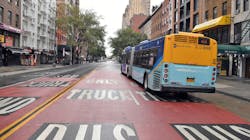Significant progress has been made in ABLE camera expansion across NYC bus routes
Significant progress has been made in the expansion of Automated Bus Lane Enforcement cameras (ABLE) across Metropolitan Transportation Authority (MTA) bus routes in New York City (NYC). ABLE cameras capture drivers violating bus lane rules in real-time and are aimed at deterring motorists from blocking the lanes to improve bus service and reduce crashes.
As part of the Fiscal Year 2024 budget, New York Gov. Kathy Hochul successfully secured the expansion of the ABLE program to include more traffic violations and protect New Yorkers. On Sept. 25, ABLE cameras will be activated on the B26 bus route serving riders in Brooklyn and Queens, marking the 20th activation of ABLE cameras across the city’s bus system and the fourth this year. Average daily ridership on the B26 is 8,700 and the route carried 1.7 million riders by the end of 2022, a 12 percent increase from 2021.
“Millions of New Yorkers rely on our buses every day and they deserve to ride in bus lanes that are safe and efficient,” Gov. Hochul said. “The continued expansion of ABLE will both protect riders and enable faster, more reliable service for New Yorkers to enjoy.”
“Queens and Brooklyn drivers take note – if you invade our bus lanes, we will catch you on camera, and you will be ticketed. We thank the governor and legislature for funding the latest expansion of this technology in the 2023 state budget. It’s an important new tool as we work to speed our bus system citywide,” said MTA Chair and CEO Janno Lieber.
Based on August 2023 data, the average speed on the B26 is 6.7mph – four percent slower than the average Brooklyn local or limited route. Since the implementation of ABLE along several bus routes in Brooklyn, average bus speeds in the borough have seen increases of approximately five percent and collisions with buses have decreased by nearly 20 percent, as most motorists who receive a notice or violation are unlikely to become repeat offenders. Based on previous data collected, of all the drivers who have received at least one ABLE violation, MTA notes only eight percent have received three or more. Citywide, ABLE cameras have led to more than 313,000 violations being issued to motorists through the end of August.
With the activation on the B26 route, the MTA will have 585 buses equipped with ABLE cameras on 20 routes across all five boroughs of NYC. Locations were determined to maximize the length of bus lanes covered, balance distribution between boroughs, address some newer bus lanes and incorporate input from the MTA and the NYC Department of Transportation (NYCDOT) on known locations with issues.
Upon implementation of ABLE cameras on the B26, NYCDOT will issue warning notices to motorists for the first 60 days, in accordance with New York State law, to ensure drivers are informed about the program before any fines are levied. Each bus lane corridor with ABLE camera coverage has signage indicating the hours the bus lanes are operable and advises drivers the lanes are camera-enforced. Drivers who violate these rules during enforcement periods are subject to a summons, with fines beginning at $50 and escalating, for repeat offenders, up to $250.
ABLE camera systems capture license plate information, photos and videos, together with location and timestamp information. This information is then transmitted to NYCDOT for review and processing. The program is administered in partnership with NYCDOT and the New York City Department of Finance.
“Automated bus lane enforcement has proven to change driver behavior and keep our bus lanes clear. These new bus-mounted cameras will help make commutes faster and more reliable for thousands of daily commuters on the B26. NYC DOT is proud to partner with MTA to support the continued expansion of the ABLE system on routes across the city,” said NYCDOT Commissioner Ydanis Rodriguez.
“As our network of ABLE cameras continues to expand, bus customers are benefiting from faster, more reliable and safer service. Adding ABLE cameras to the B26 will keep the residents of downtown Brooklyn, Bed-Stuy, Bushwick and Ridgewood moving and keep motorists out of the bus lane,” said NYC Transit President Richard Davey.
